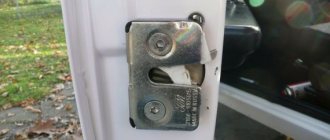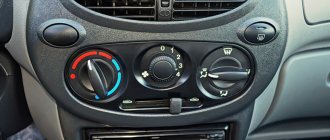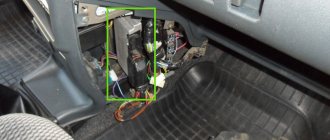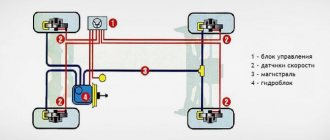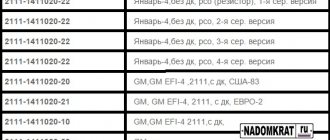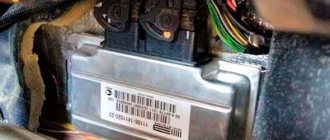Where is the Priora comfort block located?
To gain access to the product, you will need to unscrew the protective plastic walls of the car's center console. They are located on the left side of the front passenger seat and on the right of the gas pedal, on the driver's side. The device itself is located above the control unit. In order to remove the device you will need a 10 mm wrench and a Phillips screwdriver.
Pinout of the Priora comfort block
The main, important elements of the device are:
- The so-called control drivers. Each driver is responsible for a set of specific functions.
- Transponder receiver.
- Relay control.
- Transceiver. Communicates with the module installed in the door.
- 2 connectors. The first is responsible for supplying power, the second for transmitting the necessary technical information.
Click to enlarge
To ensure proper operation of all elements connected to the comfort unit connectors, it is necessary to study the correct pinout (numbered diagram for connecting wires to contacts). The design of the comfort block for the Priora, when studied in detail, is not particularly difficult.
Replacement instructions
First you need to remove the instrument panel on the center console, then remove the lower part of the dashboard trim under the steering wheel. Now you need to unscrew the fuse box and turn it so that it takes a horizontal position. You need to stick your hand into the freed space until it comes into contact with the shelf on which the TsBKE is installed.
By unscrewing the fixing bolt, you can pull up the control unit and, after disconnecting the two electrical connectors, carefully pull it out. After dismantling the device, it is repaired or replaced with a new one. Installation of the device is carried out strictly in reverse order.
The introduction of modern technologies in the field of control of electronic equipment of a car makes the driver’s work easier, frees him from unnecessary loads and reduces the likelihood of road accidents. Along with the positive aspects of the implementation of CBKE, there are also a number of disadvantages associated with the unreliability of some nodes. Factory engineers are working hard on this problem. According to recent reviews from car enthusiasts, the number of malfunctions of the central unit of body electronics and the frequency of their occurrence are decreasing.
The electrical package control unit (pictured below) Kalina Lux does not work. Or rather, it does not respond to my presses. It is illuminated, when I press the buttons, click, I hear a single short sound in the area of the speedometer/heater (you can hear it in the video below). This thing appeared in the morning, I walked away for an hour, everything worked. By evening everything stopped responding again and it’s been like this for the whole day. Neither the central locking, nor the mirrors, nor the power windows respond to my presses.. What's the matter? I disconnected the terminal for 15 minutes, it didn’t help, the alarm was starline.
Megapolis-Auto provides warranty and post-warranty support for professional anti-theft and security systems and AlarmTrade.
The company was awarded the status of "Industry Leader 2014"
New articles in the section
Using a polarized relay in a car.
Material from Maxim from the site: https://www.drive2.ru So, another useful modification of minimal complexity. With frequent and not very long trips during the day, you have to turn off the dimensions and the radio every time you get out of the car, and when you return, turn everything back on. So I thought about it
Checking the range of the Pandora DX 90B communication channel
One of the clients complained about poor communication, or rather about the short control distance and periodic loss of communication, that is, the key fob “complains” about the lack of communication (in this case it plays the melody of the lack of communication) And we had a great opportunity to deal with the problem of range,
Stealing a Lada Vesta with a magnet. How to protect yourself?
Many times in conversations with clients we discussed the issue of unlocking standard ignition locks using modern powerful magnets. And, frankly, few people believed that this was possible in principle. provided us with and also posted a video online demonstrating this method of opening
Purpose and characteristics of TsBKE
The central unit of body electronics Kalina 2 controls:
- alarm system;
- windshield wipers;
- heated windshield and rear windows;
- heated side mirrors;
- lighting system;
- direction indicators;
- central locking;
- trunk opening drive;
- electric windows;
- heated front seats;
- electric side mirrors.
When the alarm is turned on, an automatic check occurs, accompanied by a short flashing of the direction indicators. In security mode, the immobilizer light on the instrument cluster blinks. The security mode is disarmed by pressing the remote control button.
The central electronic unit automatically turns on the windshield wipers if:
- a signal was received from the rain sensor;
- sensitivity regulator in position from 1 to 4;
- The wiper switch is in the intermittent position.
When the voltage drops to 9.6 V, the central unit limits the operation of the rear window and side mirror heaters. This prevents the engine from going into emergency mode. When the voltage is restored to a level of 10.8 Volts, the heaters turn on automatically.
The driver is also assisted by body electronics when working with the lighting system. When the engine starts, the daytime running lights turn on, and when the engine stops, they turn off automatically. The low beam headlights and side lights turn on when a signal is received from the light and rain sensor. At the same time, the daytime running lights turn off. If during automatic diagnostics a malfunction is detected, the absence of a signal from the light sensor, then the TsBKE turns on the low beam and dimensions.
Pinout of the ignition switch VAZ 2101 VAZ 2107
The system in these versions is located to the left of the steering wheel. To protect against dust and burglary, it is closed with a special plastic cover.
1. "". The absence of a mark indicates that all systems are currently turned off and not working. These devices do not include brake lights, lighting, cigarette lighters and, in some models, radios.
2. "I". This position indicates a working battery, as well as the inclusion of a number of automotive equipment, such as windshield washers, headlights and some alarm functions.
3. "II". A position indicating the start of the motor system. It does not have a key lock, as there is likely to be an increased load on the starter.
4. "III". Parking mark. When the key is pulled out, it locks. To remove the block, you need to insert a key.
1. 50. Red or purple wire. Supplies voltage to the starter.
2. 15. Two-core wire with blue insulation and black stripes. Supplies current to the cigarette lighter, washer, and brake light.
3. 30 and 30/1. Pink or brown positive contact.
4. INT. Two-core black wire responsible for headlights and light signaling.
The ignition switch connection diagram gives an idea of the work plan and will allow you to independently diagnose and identify problems in the system. The VAZ ignition switch is convenient and easy to disassemble.
The ignition switch pinout may be erased. If such a defect is allowed, you can match the lock with the picture.
Basket
Double-glazed window control unit “Norma” 1118 – 6512010 for VAZ 11183 “Kalina”
Aktuator On cars of the Kalina family, 2 types of non-interchangeable (by wiring) glass unit control controller 1118 - 6512010 and 11180 - 3763040 can be installed. 1118 – 6512010 has one 25-pin connection connector, 1118 – 3763040 (1118 – 3763040 – 10) – two connectors.
Remote control system for double-glazed windows “norm” on a VAZ 11183, Kalina. Controls power windows and central door locking. When the connector is removed, the engine does not start; the device performs some of the anti-theft functions.
Connection
| № | Wire color | Purpose, addressing |
| 1 |
External Shock or Volume Sensor Input (Not Used)* 2 Pink/Black To Door Lock Switch in Switch Box
3 Brown/Green K‑Line. To Kl. 71 ECM, Cl. 18 APS‑6
4 Brown Connects to ground when the driver's door is closed
5 Gray To heated rear window element
6 Black Mass
7 Pink/White To door lock switch in switch block
8 Yellow/Blue To the instrument cluster, to the APS‑6 indicator
9 Black/White Connects to ground when the hood is opened. C VK engine compartment lamp
10 Two White/Red Connects to ground when opening the rear doors
11 Brown/Red Connects to ground when opening the right front door
12 Output 12 V power supply for external sensor (Not used)*
13
Not used
14 Yellow Pulse + 12 V, closing all doors and trunk
15 Red/Blue K class. 14 APS‑6
16 Blue with Black To left direction indicator
17 Red/Blue Pulse + 12 V, opening passenger doors
18 Red/Black Pulse + 12 V, driver door open
19 Pink/Red Impulse + 12 V, opening the trunk lock
20 Yellow/Blue To terminal “15”, via fuse F 9, in the mounting block
21 Grey/Black “-” Horn relay
22 White/Blue Connects to ground when the driver's door is opened
23 Red To permanent plus through fuse F 5, in the mounting block
24 Blue To right turn signal
25 White/Black Connected to ground when opening the trunk
* A regular shock sensor from any alarm system (Alligator, Saturn, Clifford, APS) is suitable.
+ 12 V connect to pin 12; body – on the 6th; We connect the signal wire (a ground appears on it at the moment of activity) to the 1st contact.
During normal arming, Kalina now reacts to an impact on the body (it sounds a horn and blinks turn signals). Similarly, instead of a shock sensor, you can connect a volume sensor (for example, single-level MMS‑1).
You can also connect a pager: + 12 V of the pager transmitter on pin 12, minus on pin 21.
Double-glazed window control unit 1118 – 3763040 (- 10 ) for VAZ 11183 “Kalina”
| Controller board | ||
| Controller board |
| The key code is not readable |
1 . 1 Malfunction in the VZ communication coil circuit
1 . 2 Malfunction in the circuit from the block to the communication coil to the APS ECU
1 . 3 Transponder missing in OK
1 . 4 The transponder in OK is faulty (detected during pre-production preparation)
1 . 5 The transponder in the Republic of Kazakhstan is faulty (detected during pre-production preparation)
1 . 6 Malfunction of the input transponder circuit in the APS ECU
1 . 8 The communication coil came off from the VZ pad on the inside
1 . 1 - replacement 1118 – 6105006 (set) - rearrange the transponder - rearrange the remote control 1. 2 - replacing the instrument panel harness 1. 3 -replacement of KSUD -replacement of 1118 – 6105006 (set) -replacement of remote control -train the system 1. 4 - rearrange the transponder (if there is a clean one) otherwise: - replace 1118 – 6105006 (set) - retrain the system 1. 5 - replace the remote control - train the system 1. 6 - replace the faulty unit - train the system 1. 7 - replace the remote control with a “clean” one - train the system 1. 8 - replace 1118 – 6105006 (set) - rearrange the transponder - rearrange the remote control 2. 1 W‑Line communication line break
2. 2 Malfunction of W‑Line circuits in the APS or ICS units
2. 3 Lack of supply voltage on the APS or KSUD unit
2. 4 The “Normal” electrical package is faulty (the control driver has burned out)
2. 5 KSUD does not contact
2. 1 - restore the circuit between unit No. 18 of the APS ECU and unit No. 71 of the KSUD 2. 2 - replace the faulty unit - train the system 2. 3 - eliminate the cause 2. 4 - replace the electrical package - retrain the system 2. 5 - eliminate the leak - replace the control valve - retrain the system
The read key code is not in the APS 3 memory. 1 - retrain the system 3. 2 - replace the KSUD - replace 1118 – 6105006 (set) - replace the remote control - train the system
The code of the read key is not in memory Revealed during pre-production preparation 4 beeps IC flashes The ECCS was previously trained with another system - train the system
Door pinout for first generation Kalina
In all versions of the first generation Lada Kalina, the cable routing is the same.
Driver's door
- Output to the rear harness.
- A bundle of wires for connecting the speaker.
- Locking device.
- Driver's door control switch pinout element.
- Voltage to switch harnesses.
- Connection of the harness line to the mounting unit.
- Same as 5.
- Same as 6.
- Window regulator.
For front passenger
- Exit to the stern beam.
- Output to the appropriate speaker.
- Door lock drive.
- Electric window lift key.
- Power window control unit terminal harness.
- To the switch key of the corresponding node.
- Gearbox of the above device.
Rear doors
On the rear doors, the terminals are similar for both sides. Only two terminals are used here, where the first serves to connect to the rear electrical harness. The second is designed to supply an impulse and power to lock the doors.
Typical Lada Kalina pinout intended for the rear wiring harness
- Output to the rear door harness behind the driver.
- Voltage and indication of the rear left optical element.
- Same as 1 for the opposite side.
- Terminal for handbrake output.
- Kalina instrument pinout line.
- Output to the driver's door.
- Same as 5.
- Car interior lighting lamps.
- To the left turn signal.
- Connecting the fuel pump.
- Reverse transmission lock switch.
- Continuation of the highway from the front passenger door.
- Line articulation to the rear right speaker.
- Illumination lamp for the interior of the cargo compartment.
- Auxiliary stop.
- Alarm control unit.
- Same as 13 for the opposite side.
- Rear right turn.
- Output to rear optics located on the left side of the car.
- Output to cargo compartment wiring elements.
- Heated rear windshield.
Instrument panel pinout Kalina first generation
The decoupling is considered the most complex element of a car's electrical circuit. Here there are outputs from all important elements and assemblies of the machine:
- 1-5 – outputs responsible for connecting the front beam indication;
- 2.8 – similar for the stern;
- 6,7,9,10 – continuation of lines to the mounting unit and fuse-links;
- 11 – control lines for side, head and interior lights;
- 12 – combination instrument panel;
- 13 – keys for adjusting the heater cooler positions;
- 14 – for powering the air supply box;
- 15 – factory anti-theft element – ignition unit;
- 16 – immobilizer switch;
- 17 – part of the Kalina instrument panel pinout, responsible for indicating and supplying current to the ECM;
- 18 – onboard cigarette lighter;
- 19 – emergency warning button;
- 20 – brake light button located on the pedal;
- 21 – indicator on the windshield wiper system;
- 22 – rear window heating switch;
- 23 – power supply unit for turn signals and low/far modes of head optics;
- 24 – wiper control lever;
- 25 – horn button;
- 26 – supply voltage to the light bulb in the glove compartment;
- 27 – similarly, for the on/off key;
- 28-29 – pinout for Kalina radio – standard position:
- 30 – voltage to the heater cooler motor;
- 31 – resistor network of the above element;
- 32 – main pinout of Kalina EUR;
- 33 – lighting of the ventilation channel and stove.
Front wiring harness pinout
- 1 – left head optics cable;
- 2-5 – connection chips to the dashboard;
- 6 – reverse gear activation locking element solenoid;
- 7 – key for activating the reverse gear lamp;
- 8 – voltage for starter;
- 9 – connector for connecting the line to the battery and starter;
- 10 – battery;
- 11 – electricity generator;
- 12 – the same as 1;
- 13 – relevant for hatchback, front window washer;
- 14 – washer motor;
- 15 – sensor for measuring temperature outside;
- 16 – powering the horn.
Part of the air supply unit wiring pinout diagram
- The line is a continuation of the line from the dashboard.
- Wiper motor.
- Hood closing indicator.
- Line leading to the brake reservoir sensor.
Small aft lighting harness
- Continuation of the highway to the main loop.
- Closing the cargo compartment lid.
- Cargo compartment light power switch.
- Terminal of the state license plate illumination line.
- Answer for the previous “mother”.
- Left backlight.
- Same for the right side.
Part of the wiring, ECM connection EURO-3 class
The car is available in two versions. However, the Euro 3 version is in great demand. Pinout of the control unit Kalina model BOSCH M7.9.7, M 73 with 81 contacts:
- 1 – for the 16 valve version – ignition coil 2 combustion chambers, in the 8 valve version. not used;
- 2 – for 8 valves is responsible for 2-3 clamping coils. In 16th grade. only for 3 boilers;
- 3 – grounding to the body from a short circuit;
- 4 – not applicable for 8 valves (empty). On a more powerful version, it is responsible for cylinder 4;
- 5 – for 16 kl, supplies power to 1 kat. Clamp For anlaog, he is responsible for blocks 1 and 4;
- 6-7 – Injector driver No. 2, 3;
- 8 – electronic signal for indicating engine speed;
- 9 – not used;
- 10 – gasoline consumption indicator;
- 11 – empty;
- 12-13 – from the battery to the ignition;
- 14 – main relay – current supply;
- 15 – DPKV input response;
- 16 – reception from the TPS sensor;
- 17 – similar element – grounding on the car body;
- 18 – response from DK 1;
- 19 – knock sensor input;
- 20 – land DD No. 2;
- 21-26 – not used;
- 27 – drive of the first nozzle;
- 28 – heater DK2;
- 29 – power output of the control unit for coolant fan No. 2;
- 30 – free;
- 31 – lamp performance – check the engine;
- 32 – TPS controller;
- 33 – power supply to the mass air flow sensor;
- 34 – receiving an impulse from the DPKV;
- 35, 36 – ground of the corresponding sensors;
- 37 – impulse transmission channel from the mass air flow sensor;
- 38 – empty;
- 39 – power output of antifreeze temperature sensor;
- 40 – DTVV – signal reception;
- 41-43 – not used;
- 42 – receiving an impulse from the DNRD;
- 44 – per main module;
- 45 – for phase distribution sensors;
- 46 – adsorber valve, control part;
- 47 – voltage for injector No. 4;
- 48 – heater circuit DK1;
- 49, 52, 54, 56, 58, 60, 62 – empty;
- 50 – extra Starter relay;
- 51, 53 – taps to the ground;
- 55 – pulse receiving line from DC2;
- 57 – calibration of short circuit to ground;
- 59 – speed sensor sensor;
- 61 – on the body;
- 63 – from the main control relay;
- 64-67 – XX calibrators;
- 68 – control of cooling system fan No. 1;
- 69-70 – power lines for the fuel pump and air conditioning relays, respectively;
- 71 – K-Line;
- 72-74 – not used;
- 75 – request on. Air conditioning systems inside the cabin;
- 76 – impulse to activate the power steering unit;
- 77-78 – empty;
- 79 – input from DF;
- 80 – body weight;
- 81 – empty.
CBKE schemes
_x000D_
_x000D_
Electrical connection diagram for TsBKE on LADA VESTA: 2 – rechargeable battery; 3 – starter; 4 – rear left outer lamp; 5 – left headlight; 7 – rear window heating relay (K3); 8 – right headlight; 10 – rear outer right lamp; 13 – trunk light; 15 – fuse 60 A (F70); 16 – additional relay (K8); 17 – ignition switch; 26 – alarm switch; 30 – fuse 5 A (F20); 32 – left steering column switch (light alarm switch); 34 – fuse 60 A (F75); 35 – rear window heater; 44 – windshield heating relay 1 (K21); 46 – windshield heater; 47 – lampshade lighting of the glove box; 48 – switch for the glove compartment lamp; 51 – TsBKE (VSM controller); 58 – fuse 30 A (F61); 59 – left threshold lamp (installed on luxury equipment); 60 – right threshold lighting lamp (installed on the “luxury” configuration); 61 – relay of additional consumers (K2); 63 – fuse 10 A (F32); 84 – fuse 3 A (F43); 87 – left outside mirror; 88 – right outside mirror; 120 – additional starter relay (K23); 134 – brake signal switch; 138 – fuse 5 A (F15); 164 – air conditioner control panel (connection diagram for the “comfort” package); 185 – interior lighting unit with ERA-GLONASS interface module; 196 – fuse 5 A (F24); 200 – fuse 15 A (F11); 201 – fuse 15 A (F12); 202 – fuse 10 A (F13); 203 – fuse 10 A (F14); 204 – fuse 5 A (F17); 205 – fuse 5 A (F16); 229 – fuse 3 A (F49); 230 – clutch pedal position signal switch; 231 – windshield heating relay 2 (K22); 233 – fuse 5 A (F80)
_x000D_
- _x000D_
- location of fuses F1-F59 and relays K1-K20 in the interior mounting block;
_x000D_
location of fuses F60-F80 and relays K21-K28 in the motor mounting block
_x000D_
_x000D_
_x000D_
Electrical connection diagram of the TsBKE on LADA VESTA (Comfort package): 2 – rechargeable battery; 3 – starter; 9 – rear inner left lamp; 15 – fuse 60 A (F70); 16 – additional relay (K8); 17 – ignition switch; 20 – fuse 15 A (F1); 23 – rear inner right lamp; 28 – fuse 5 A (F74); 31 – reverse light switch; 33 – right steering column switch (windshield wiper switch); 51 – TsBKE (VSM controller); 63 – fuse 10 A (F32); 79 – electric motor for windshield wiper; 80 – washer motor; 120 – additional starter relay (K23); 198 – fuse 25 A (F40);
_x000D_
- _x000D_
- location of fuses F1-F59 and relays K1-K20 in the interior mounting block;
_x000D_
location of fuses F60-F80 and relays K21-K28 in the motor mounting block
_x000D_
_x000D_
After replacing the TsBKE, it is necessary to perform the training procedure (entering parameters) and automatic configuration of the TsBKE using the Grade-X diagnostic device. You can also view error (fault) codes using this device. You can get acquainted with the functionality of the CBKE in more detail, as well as its diagnostics, using the TI (device, fault diagnosis of the CBKE).
_x000D_
On the one hand, this functional device allows you to more finely tune the operation of the electronics. On the other hand, the unit has a complex structure, which makes independent repairs more problematic. If the TsBKE fails, you will have to contact the dealer, because It is unlikely that the necessary equipment for programming or diagnostics will be at hand.
_x000D_
Attention! It is impossible to retrain a CBKE taken from another vehicle. _x000D_
_x000D_
Which implementation do you like best? The presence of a simple circuit, where there are turn relays, ESP, etc., or the presence of a central electronics control unit? Find other materials on repair, maintenance, modifications and tuning of these cars in the contents (XRAY crossover, Lada Vesta sedan).
Categories of products that may be of interest to you based on the article “Central unit of body electronics Lada Vesta and XRAY (description, reviews)”:
Granta and Starline - all options
0 people signed up. Next goal: 100
From the very beginning of sales of the new Lada Granta family, owners began to experience inconvenience when using the central locking (CL). The fact is that in some car versions, when the engine is running, the central lock only closes the driver's door. Closing all doors is only possible when the ignition is turned off. This algorithm for the operation of the central lock complicates life for owners when installing an additional car alarm with auto start.
Here's what Lada Granta FL owners write in one of the VK groups:
The new FL grant has a strange locking mechanism. 1. if you lower the driver's flag when the car is turned off, then all the others will lower and close, everything is fine. 2. If the engine is running, then when the driver's flag is lowered, the rest remain open. Well, God bless him, maybe the thieves won’t get caught in the traffic jam. BUT! When you arm the car with a manual transmission and get out of the car, the engine naturally runs before arming...you arm it and...since the engine is running, one driver's flag goes down. Three passenger doors remain open. Pressing the close button again does nothing. You have to disarm and re-arm, and this already resets the autorun. Indeed, such an algorithm for the operation of the central locking is indicated in the car’s operating manual:
Central locking and unlocking of side doors from the passenger compartment (in a variant). To lock the side door locks from inside the vehicle, press the lock button into the driver's door or (in the optional version) press the lock button in the driver's door module. In versions with a driver's door module, locking the side doors using the button in the driver's door is only possible when the ignition is turned off. At the moment, this information has already been conveyed to AvtoVAZ. It remains to be hoped that this feature of the central locking system will be corrected in the near future.
Finally got around to installing a new power window switch assembly. I started by inserting a new block from Kalina 2 in place of the original one. Using plastic spatulas to remove the trim, I removed the Granta power window switch block.
On the website where I ordered the block (see part 1), there is a template for marking.
I removed the original block and marked the casing for the new one.
I cut out the seat with a utility knife.
Installed a new block.
The next step was to remove the casing and conduct +12V, which I took from the fuse of the factory central locking unit (it seemed logical to me
Ways to solve problems with central locking Niva Chevrolet
Before starting work, it is recommended to evaluate your repair skills and experience with electrical wiring in a car. Special equipment may be required, and at a minimum, a tester is required to diagnose electrical circuits. Troubleshooting always starts from simple to complex.
Fuse failure
The fuse is the first thing every car owner should check if the central locking stops working. The symptom will be the failure of all doors to close with the button at the same time. It's easy to check - just open the mounting block and replace it with a serviceable one of the same rating.
Most often, the cause of its burnout is a short circuit or overload in the circuit. In the mounting block of cars manufactured before 2009, it is designated F6; on cars after 2010, it is located under the number F10.
Gearbox lever rattling
For LADA Kalina, a typical malfunction is rattling in the area of the gearshift lever, which mainly becomes noticeable when the engine is running at speeds of about 3000. The source of the side sound is the bushing, which is made a little thicker than necessary, and because of this, a gap appears in the mount. To resolve this problem you need to do the following:
- remove the handle cover, which is attached with latches;
- using two 13mm wrenches, unscrew the nut and bolt;
- remove washers and bushings;
- to eliminate rattling, the bushing in the middle needs to be slightly sharpened in width or the mount should be lubricated with sealant;
- Having done this, mount everything back. The sealant does not help out every time, but if you sharpen the bushing by 0.3 mm, the result is guaranteed.
It’s safe to say that repairing a Lada Kalina car yourself is not so scary. Every car enthusiast has the opportunity to eliminate minor malfunctions of this car. You just need to believe in yourself, follow our advice and everything will work out!
Bottom line
The pinout of panels of the Kalina car from Lada is distinguished by its simplicity and reliability. There are no complex controllers or blocks here. Consequently, system maintenance and troubleshooting do not require in-depth knowledge of electronics or expensive tools.
Sources
- https://1ladakalina.ru/komplektuyuschie/blok-upravleniya-elektropaketom.html
- https://Vaz-Russia.com/remont-vaz-1118-kalina-sedan/raspinovka-lada-kalina.html
- https://avtozam.com/vaz/lada-kalina/tsentralnyj-blok-kuzovnoj-elektroniki/
- https://l2rv.ru/info/raspinovka-jelektropaketa-kalina-ljuks/
Non-specific types of services
Even if the rules for safe operation of the vehicle are observed, the heater control unit may require servicing or replacement. This happens as a result of sudden switching of the heating knob of the Lada Kalina car. The operating instructions indicate that you must wait until the system warms up to a minimum, otherwise expensive repairs will be required.
From a financial point of view, the stove control unit will not be cheap, so its careful operation will save the family budget.
The heater control unit cannot be replaced independently due to the need to use special equipment. Much less often problems arise at the level of the engine control system.
The need to visit a service station will be caused by driving on a gravel road, an accident, or the result of unprofessional maintenance. The engine management system is responsible for fuel injection, so any deviations in its operation immediately put the car on hold. How long it will take to replace the engine control unit will be decided by the technician after an inspection.
It is cheaper, but repairs take much longer when the body electronics unit comes under attack. The problem can only be diagnosed in a service center. The duration is due to the fact that if the engine control unit can be replaced as a single whole, then part of the wiring must be changed along with the electronics.
Voltage surges or a simple short circuit can damage a certain sector. The light control unit will be the first to tell you about this.
Incorrectly working turn signals or emergency lights are the first sign indicating a failure in the electronic component of the car. There is no point in delaying a visit to the service center. Otherwise, the ESP unit responsible for dynamic stabilization will come under attack. Even with minor problems, the driver will notice a decrease in the lateral dynamics of the vehicle.
Personalize existing features
The manufacturer has provided for the timing of regular technical inspections, which are mandatory. For non-compliance, the company reserves the opportunity to deprive the car owner of the right to free service.
The most vulnerable is the comfort block, which includes many logical circuits. Its purpose boils down to the following functions:
- activation of interior lighting;
- adjusting the operation of car alarms;
- turning on the heated rear window;
- automatic mirror adjustment;
- control of electric windows;
- remote control of locks.
The manufacturer has provided the ability to personalize each element. To do this, the electrical package control unit must be recoded at an authorized automotive center. Using official software, the wizard will add or remove certain features. If everything is done correctly, 20 minutes after requesting the appropriate service, you can safely use the “iron horse”.
According to reviews from car enthusiasts, the Lada Kalina car is distinguished by electronic filling with increased sensitivity to operating conditions. Aggressive driving style and minor damage lead to malfunctions.
As a result, you need to visit a service station to replace the device. To do this, remove the control unit, which must be done as follows:
- turn off the battery;
- unscrew the screws from the driver's seat;
- Use a ratchet wrench to remove the nut;
- the plastic plug is squeezed out completely;
- carefully pull out the seat;
- remove the seat by dismantling the terminals;
- remove the cover plate.
The replacement procedure on the Kalina 2 model is completed by folding the carpet and installing a new block. After this, all procedures are carried out in reverse order.
Seats: too dirty upholstery and everything that follows from this
In the configurations of Luxury cars, starting from the 1st generation of cars, fabric was used for seat upholstery, which was too classy. VAZ was supposed to solve this problem in the spring of 2014. The new fabric, oddly enough, ended up not being much better than the old one. Advice from experienced people: you need to put covers on the seats.
Structure of the new upholstery fabric designed for luxury trim levels
By the way, leather cases conduct heat very poorly. In trim levels where heated seats are provided, there is no point in using such a solution - heating will proceed very slowly. The owner should be aware of this so as not to waste a significant amount on an expensive and useless addition.
Let's ask ourselves how much of a brand the fabric of the standard upholstery actually is. If we talk about difficult operating conditions, then, according to reviews, you have to clean the seats once every six months. Make a choice.
Prevention
As a measure to prevent breakdowns, experienced specialists recommend periodically performing maintenance on electrical circuits. This requires a complete review of all wires and disconnectors twice a year for damage to the braiding and oxidation of copper contacts. Damaged parts or loose joints must be replaced with new ones.
Also, advice from “experienced” motorists speaks of the rationality of treating parts with special dielectric oil - this prevents air and moisture from entering sensitive areas and significantly increases the service life of devices.
Replacement features
Briefly about the procedure for replacing the control module on Kalina 2:
First, the instruments are dismantled from the center console; there is nothing difficult about it. Then the lower part of the center console trim is unscrewed, the trim is removed, and you gain access to the fuse and relay box. The mounting block with safety devices can be unscrewed, but it cannot be removed because it is connected by wires. You can rotate it a little so that it takes a horizontal position. You can stick your hand into the gap formed as a result of turning. Having done this, you will be able to feel the shelf on which the TsBKE is installed. A little to the left there is a bolt with which this module is fixed - you need to unscrew it. After this, through the top, through the instrument panel, you will need to disconnect the two connected connectors
After completing these steps, you can carefully dismantle the CBKE and remove it by slightly moving the fuse box. Please note that you should not pull the device too hard, since on the other side there are two more connectors that will need to be disconnected
When the wires are disconnected, the CBKE can be completely dismantled and repaired or replaced.
Replacement features
Briefly about the procedure for replacing the control module on Kalina 2:
First, the instruments are dismantled from the center console; there is nothing difficult about it. Then the lower part of the center console trim is unscrewed, the trim is removed, and you gain access to the fuse and relay box. The mounting block with safety devices can be unscrewed, but it cannot be removed because it is connected by wires. You can rotate it a little so that it takes a horizontal position. You can stick your hand into the gap formed as a result of turning. Having done this, you will be able to feel the shelf on which the TsBKE is installed. A little to the left there is a bolt with which this module is fixed - you need to unscrew it. After this, through the top, through the instrument panel, you will need to disconnect the two connected connectors
After completing these steps, you can carefully dismantle the CBKE and remove it by slightly moving the fuse box. Please note that you should not pull the device too hard, since on the other side there are two more connectors that will need to be disconnected
When the wires are disconnected, the CBKE can be completely dismantled and repaired or replaced.
Diagnostics
You can diagnose problems without a special lift, but this requires hanging the suspected wheel. The use of high-quality bearings allows the car to have no play in the hub, or it can be insignificant (with certain wear, but not yet in critical condition).
After hanging the wheel, you need to forcefully try to shake it in different directions. A serviceable bearing will not give any play or it will be almost unnoticeable. A faulty one can have strong rolling, even without the use of force.
In this case, only replacing the wheel bearing in the field will help. Adjustment and any types of straightening will no longer be effective.
Also interesting: How to find out the color of a car

